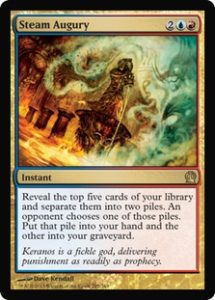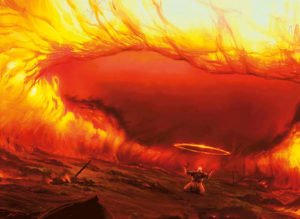This week in Uncharted Realms, we visited the hitherto-unknown plane of Kaladesh to discover the backstory of Chandra Nalaar. Gifted with the rare (and, in her culture, illegal) power of fire magic, Chandra and her family are hunted by the powers-that-be on her world as a threat to social and magical order. At the moment of her execution, Chandra’s spark ignites, hurling her through the planes to arrive on Regatha, where she is greeted warmly as a budding pyromancer. Her innate gift of pyromancy marks her as unique in Magic’s multiverse, but this power is part of a long tradition in Earth’s history, dating back as long as humanity’s dependence and fixation upon fire.
Pyromancy
The word pyromancy owes its creation to the ancient Greeks, but its the practice goes back further than its Greek definition more than 2,000 years ago. The name refers to fire, “pyro,” and divination, “manteia,” the practice of predicting the future or interpreting divine will. Despite her mastery of fire magic, Chandra is not, strictly speaking, a pyromancer according to its manifestation on Earth – she is a pyrokinecticist, one who controls and wields fire as a weapon. She could, however, visit a Temple of Epiphany on Theros to witness the practice of divination by flame (or its appropriate Blue-Red byproduct, steam).
Pyromancy has a long history alongside various forms of augury in tradition and religious practice. Fire crackles and hisses like a living spirit, grants life in cold winters, brings death in conflagration, creates edible food from raw meat and iron tools from raw metal. It is likely that fire has been revered and studied as a source of spiritual knowledge since its first discovery by prehistoric peoples.
The archaeological record bears witness to multiple kinds of ancient fire divination magic. First, fire itself was studied for the shapes it took and the smoke it elicited. This practice, known as capnomancy, was practiced in various forms long before the Greek word for fire divination came into existence. Evidence exists in ancient China and Mesopotamia of soothsaying using the direction, density, and behavior of rising smoke to determine the course of the future. Over time, this practice became a more complex ritual in Chinese, Mesopotamian, and ultimately Greek society, with formulas to determine what each configuration of smoke entailed as well as incense, herbs, and oiled firewood for specific incantations.
Fire crackles and hisses like a living spirit, grants life in cold winters, brings death in conflagration, creates edible food from raw meat and iron tools from raw metal.
The introduction of tools to the practice of pyromancy did not stop with incense. One of the most enduring and complex forms of pyromancy in human religious tradition is osteomancy, the burning of bones to foretell the future. Practiced widely throughout ancient east Asia with ox bones and turtle shells, this type of pyromancy involved casting animal bones (sometimes etched with magical formulae) into a fire and reading the fissures that developed in the heated bone. Osteomancy dates back at least three thousand years on the Eurasian continent, existing in various forms through many cultures. Ultimately, pyromancy may be responsible for the invention of writing in the Chinese cradle of civilization, as the inscriptions used on bones for osteomancy eventually evolved into the more widely-used Chinese script.1
Snuffing the Flame
Pyromancy, despite its long history in human tradition, was not always embraced as a form of religious divination and expression. As on Chandra’s plane of Kaladesh, there have been epochs of human history where pyromancy has been forbidden or outlawed. Fire magic is listed in a medieval manuscript, “The Book of Forbidden Arts, Heresy, and Sorcery,” written for a curious nobleman of the Holy Roman Empire in the 15th century. The author declaims pyromancy amongst other forms of soothsaying as illegal and profane magic. The art of divination, he says, is dangerous, for “its beginning is sweet, but its end is for the soul a bitter eternal damnation without end.”2
Unlike Chandra’s fire magic, the pyromancy of Earth’s history is limited to insight into divine intent and the trajectory of the future. It was not dangerous in a literal sense to the Abrahamic faiths and societies of the medieval Mediterranean world, as one might say of uncontrollable pyrokinesis on Kaladesh. The warning of the author of “The Book of Forbidden Arts, however,” hints at the danger entailed in pyromancy: it was counted as heresy, as its practice invoked divine guidance and magic outside of scriptural canon.
“Its beginning is sweet, but its end is for the soul a bitter eternal damnation without end.”
It is likely that we’ll go more in depth into the topic in the coming weeks, but heresy was a significant concern for medieval peoples. Like a catching fire, heresy could spread through the religious communities of the medieval period, misleading the faithful away from sanctioned doctrine and into damnation. Countless writers decrying heresy within Islamic and Christian tradition would have agreed with the antagonist of this week’s Uncharted Realms speaking of Chandra’s pyromancy: “Ultimately, it will bring nothing but ruin to its wielder.”
Despite these dire warnings and periods of official condemnation, pyromancy and osteomancy still thrive around the world today. Taoist, Shintoist, and other traditional religious practices hold to prediction of the future by fire. In many ways, fire is still key to religious experience and ritual, even if it does not maintain the same magical and predicative role. Purification and ceremony by exposure to smoke and fire continue in Abrahamic tradition and religious ceremony throughout the globe. Pyromancy and fire magic, whether on Kaladesh or Earth, has a long history despite intermittent opposition – it is a hard flame to completely extinguish.
Join me next week to look at Liliana’s backstory on Dominaria, where we’ll probably talk about some more spicy heresy since it’s literally part of her new card name!
1Joshua Mark, “Writing: Definition,” (Ancient History Encyclopedia). Available <http://www.ancient.eu/writing/>.
2http://www.occultcenter.com/2009/06/download_15_century_manuscript_of_book_of_all_forbidden_arts/ (The download is in German).



